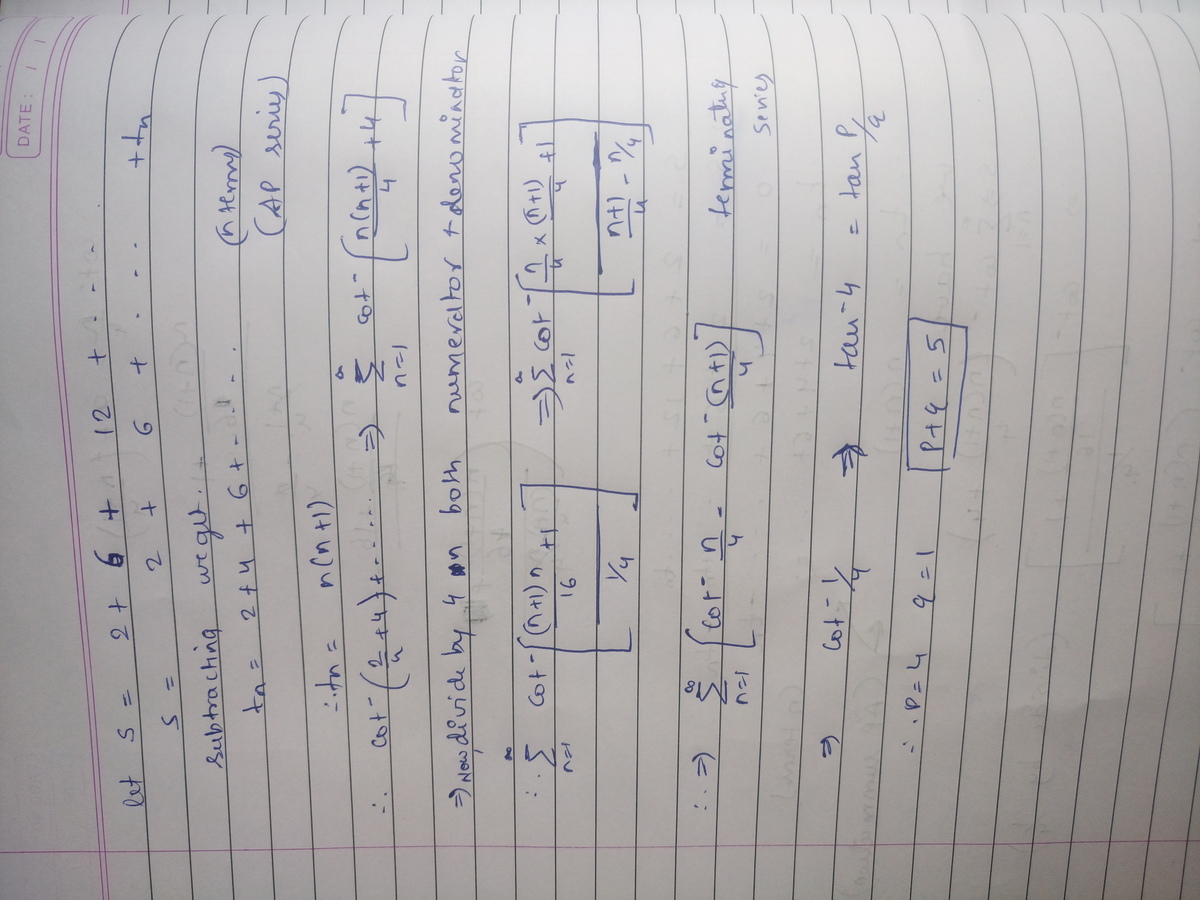Inverse Trigonometric Functions#0
cot − 1 ( 4 2 + 4 ) + cot − 1 ( 4 6 + 4 ) + cot − 1 ( 4 1 2 + 4 ) + ⋯ = tan − 1 ( q p )
The equation above holds true for coprime positive integers p and q . Find p − q .
The answer is 3.
This section requires Javascript.
You are seeing this because something didn't load right. We suggest you, (a) try
refreshing the page, (b) enabling javascript if it is disabled on your browser and,
finally, (c)
loading the
non-javascript version of this page
. We're sorry about the hassle.
3 solutions
@Manu Sharma , could u pls explain how u solved this problem ?? Also(general doubt) how to solve such type of inverse+series problems ??
@Aakhyat Singh solution posted. Now coming to ur doubt, always try to frame terminating series(it will always be there atleast till where level of Iit is concerned) for ex. U could check the solution posted above.

Let S n = k = 1 ∑ n cot − 1 ( 4 k ( k + 1 ) + 4 ) = cot − 1 a n . From the first few a n , we note that a n = 4 n n + 1 7 . Let us prove in by induction that the claim is true for all n ≥ 1 .
Proof: For n = 1 , a 1 = 4 ( 1 ) 1 + 1 7 = 2 9 = 4 2 + 4 as given. The claim is true for n = 1 . Assuming the claim is true for n , then:
S n + 1 = S n + cot − 1 ( 4 ( n + 1 ) ( n + 2 ) + 4 ) = cot − 1 a n + cot − 1 ( 4 n 2 + 3 n + 1 8 ) = cot − 1 ( 4 n n + 1 7 ) + cot − 1 ( 4 n 2 + 3 n + 1 8 ) = cot − 1 ⎝ ⎛ ( 4 n n + 1 7 ) + ( 4 n 2 + 3 n + 1 8 ) ( 4 n n + 1 7 ) ( 4 n 2 + 3 n + 1 8 ) − 1 ⎠ ⎞ = cot − 1 ( 4 ( n 3 + 3 n 2 + 1 9 n + 1 7 ) n 3 + 2 0 n 2 + 6 5 n + 3 0 6 ) = cot − 1 ( 4 ( n + 1 ) ( n 2 + 2 n + 1 7 ) ( n + 1 8 ) ( n 2 + 2 n + 1 7 ) ) = cot − 1 ( 4 ( n + 1 ) n + 1 8 )
Therefore, the claim is also true for n + 1 and hence true for all n ≥ 1 .
Now, we have n → ∞ lim S n = n → ∞ lim cot − 1 ( 4 n n + 1 7 ) = n → ∞ lim cot − 1 ( 4 1 + n 1 7 ) = cot − 1 ( 4 1 ) = tan − 1 4 .
Therefore, p − q = 4 − 1 = 3 .